Calculation and simulation of the current effects on maritime safety in Haiphong fairway, Vietnam
Haiphong is the biggest port in the Northern region, with 80 million tons of cleared goods
passing through it in 2015. Haiphong fairway with 85 km length with high density of the maritime
transports, plays the vital role in the Vietnam Northern waterway system. Moreover, in this one-direction
fairway still remain complicated natural features such as many bends, branches, shallow spots and strong
current and these factors are the potential causes for maritime accidents.
One of the reasons leading to these accidents in this channel (mainly grounding and collision) is the
direct effect of the current on the process of ship course control which is pre-programmed.
With the features mentioned above, this paper focuses on analyzing the areas which potentially have
maritime risks, as well as reasons for maritime accidents involving current effects such as: Interaction
between rudder and propeller; impact on vessel’s shell when altering course; rudder cavitation problems.
According to these facts, the authors built a research model and a mathematical one by basing on the
BEM method and simulating them by the Fluent-Ansys software. Then, results of simulated calculation
of the current effect on controlling ship course in the Haiphong fairway are presented in order to improve
the safety of navigation in this channel
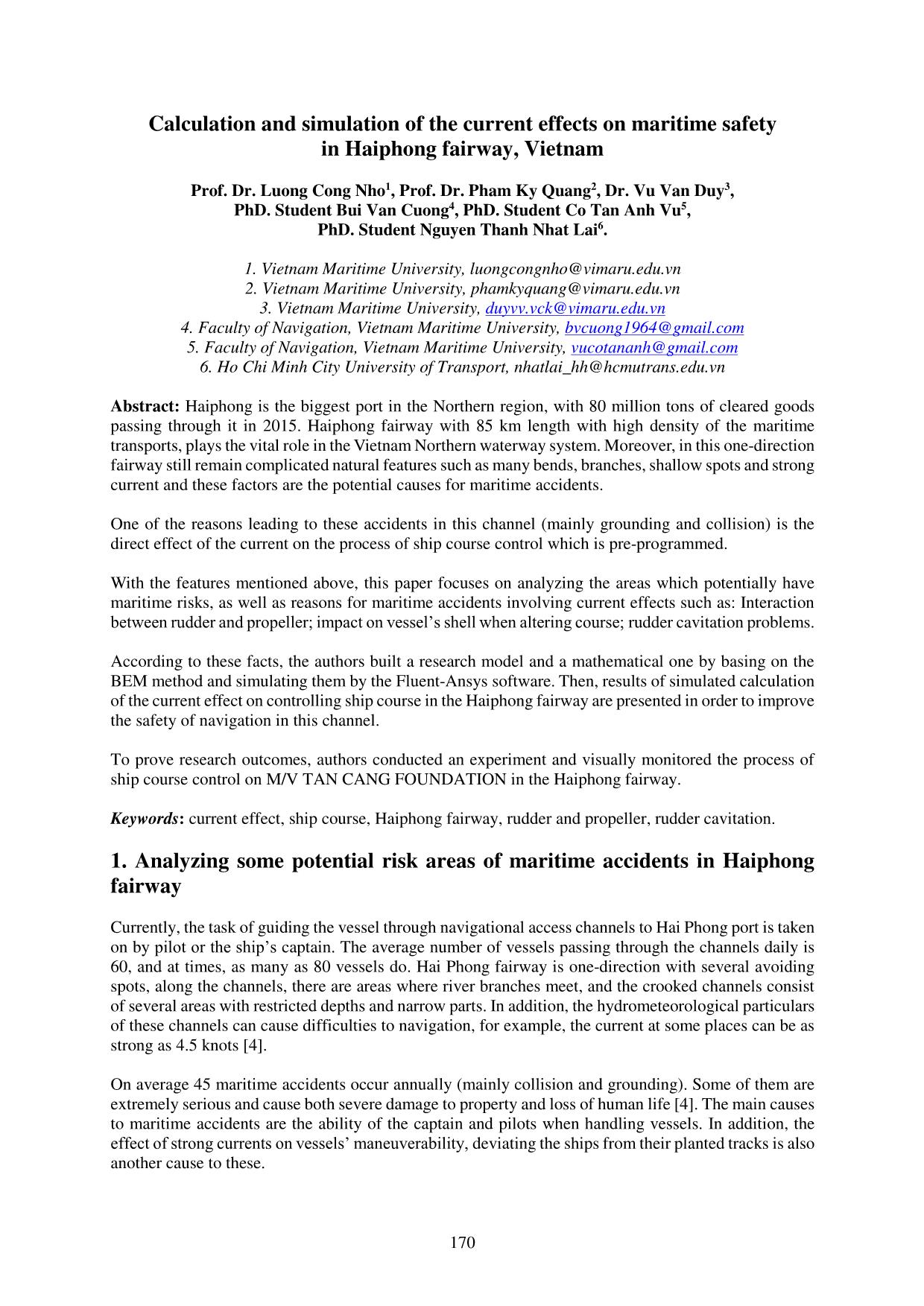
Trang 1
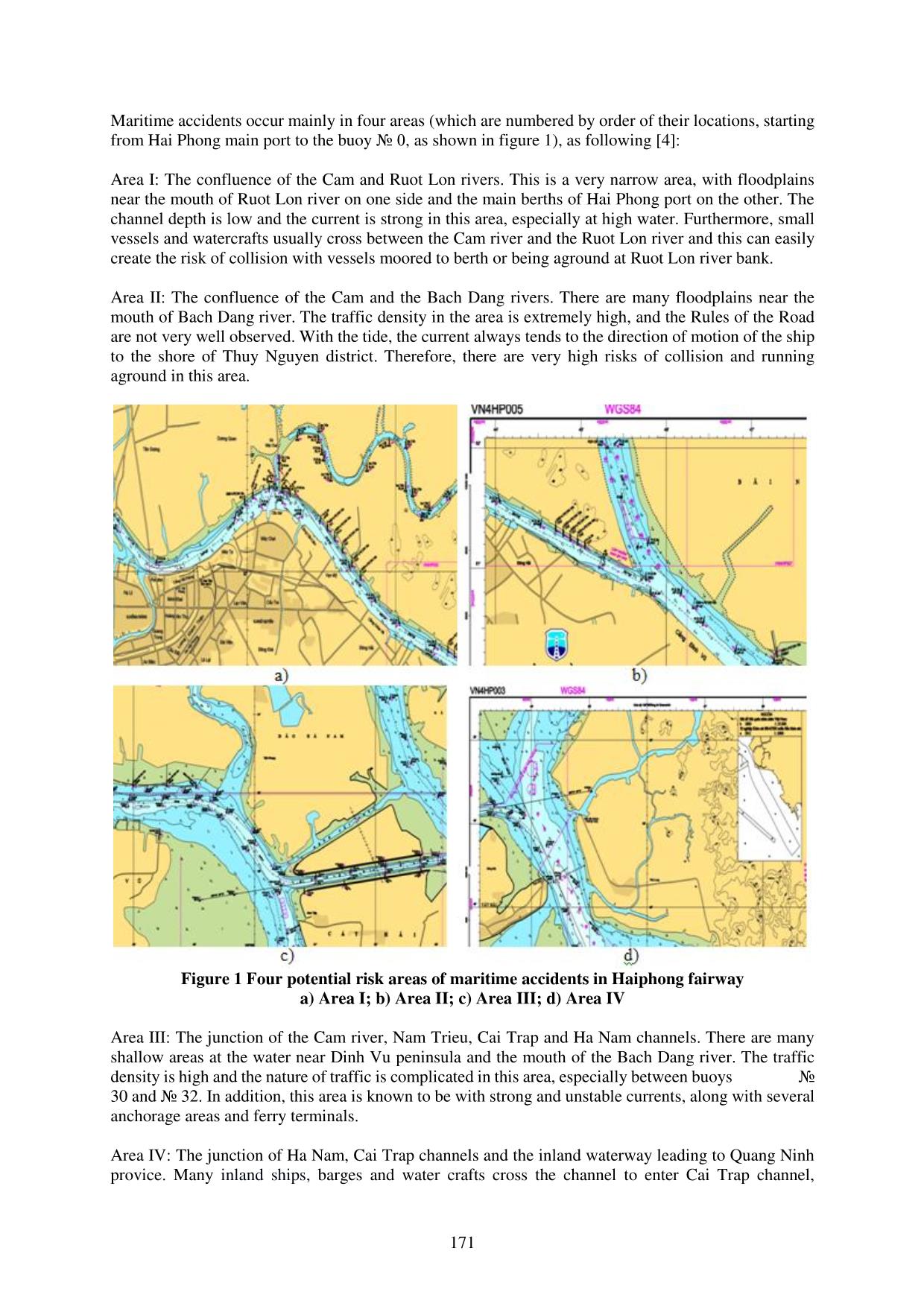
Trang 2
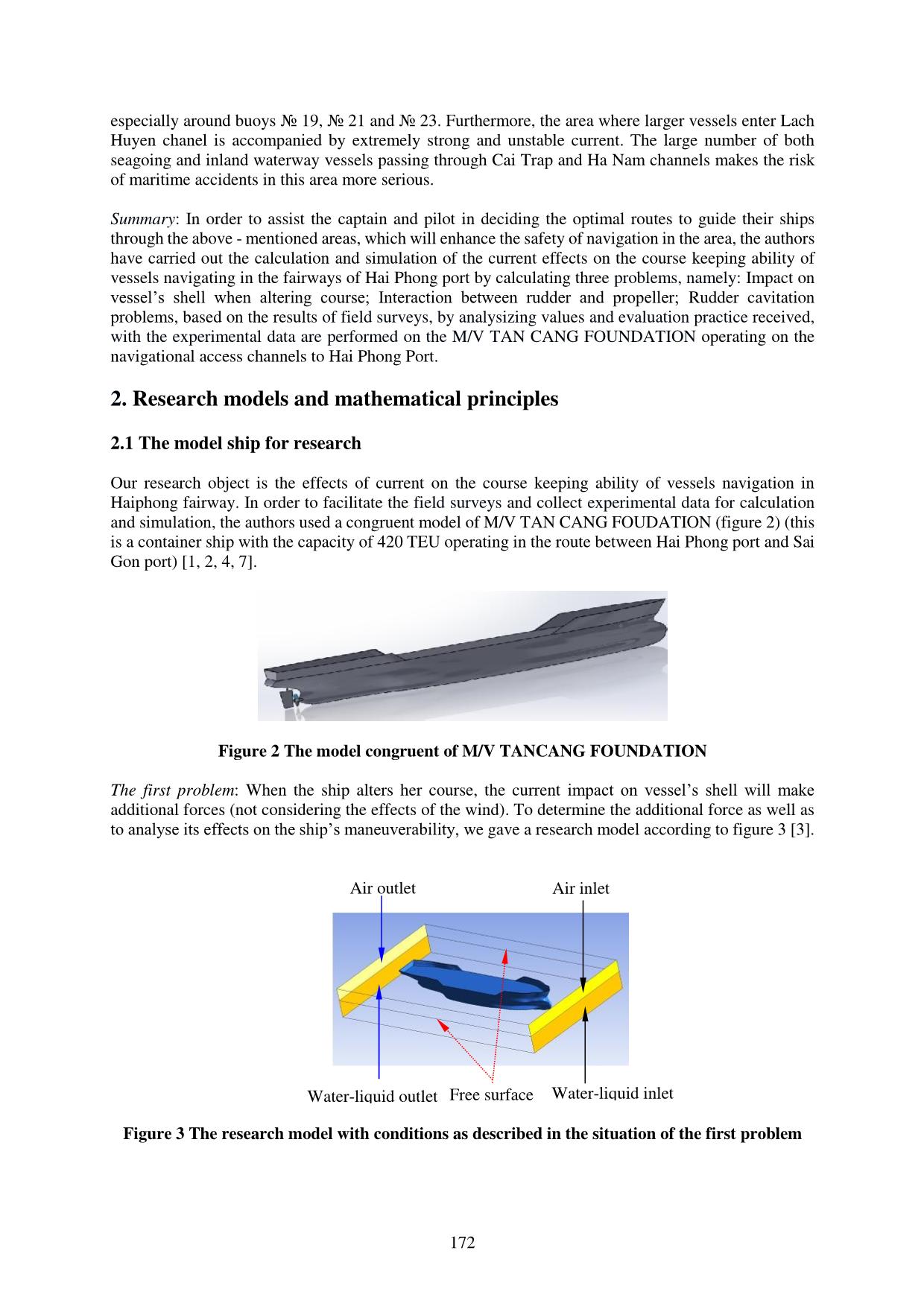
Trang 3

Trang 4
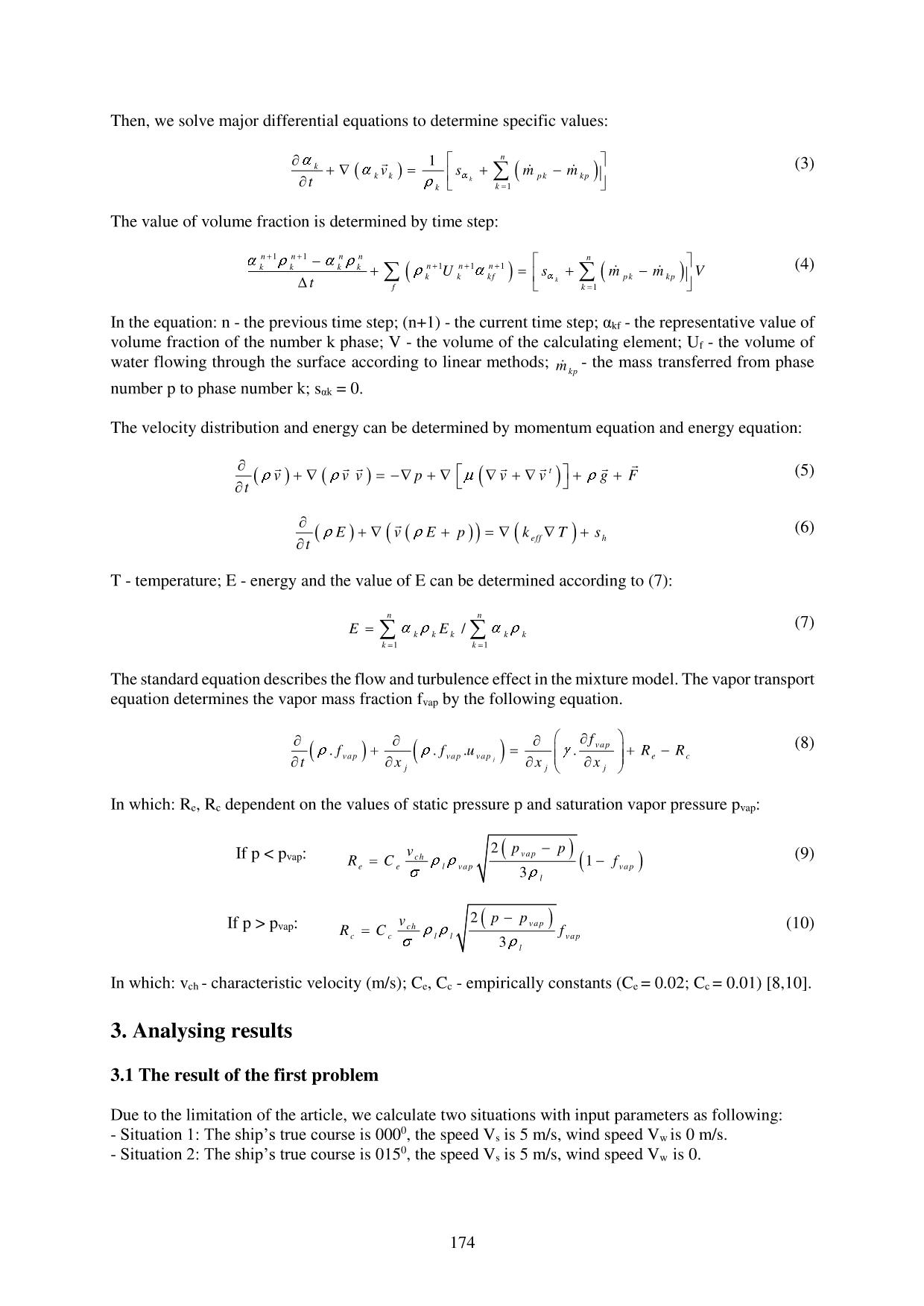
Trang 5
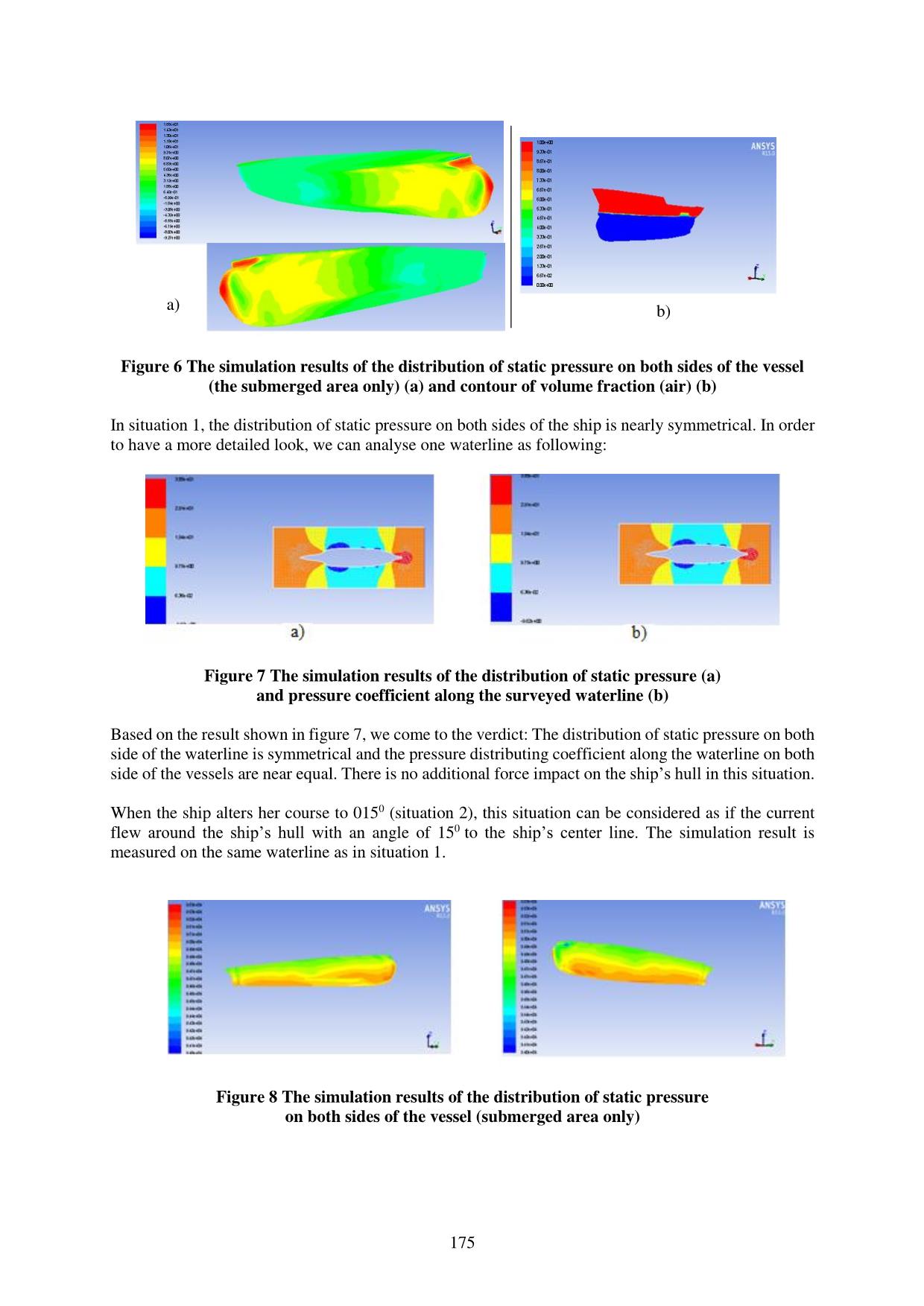
Trang 6
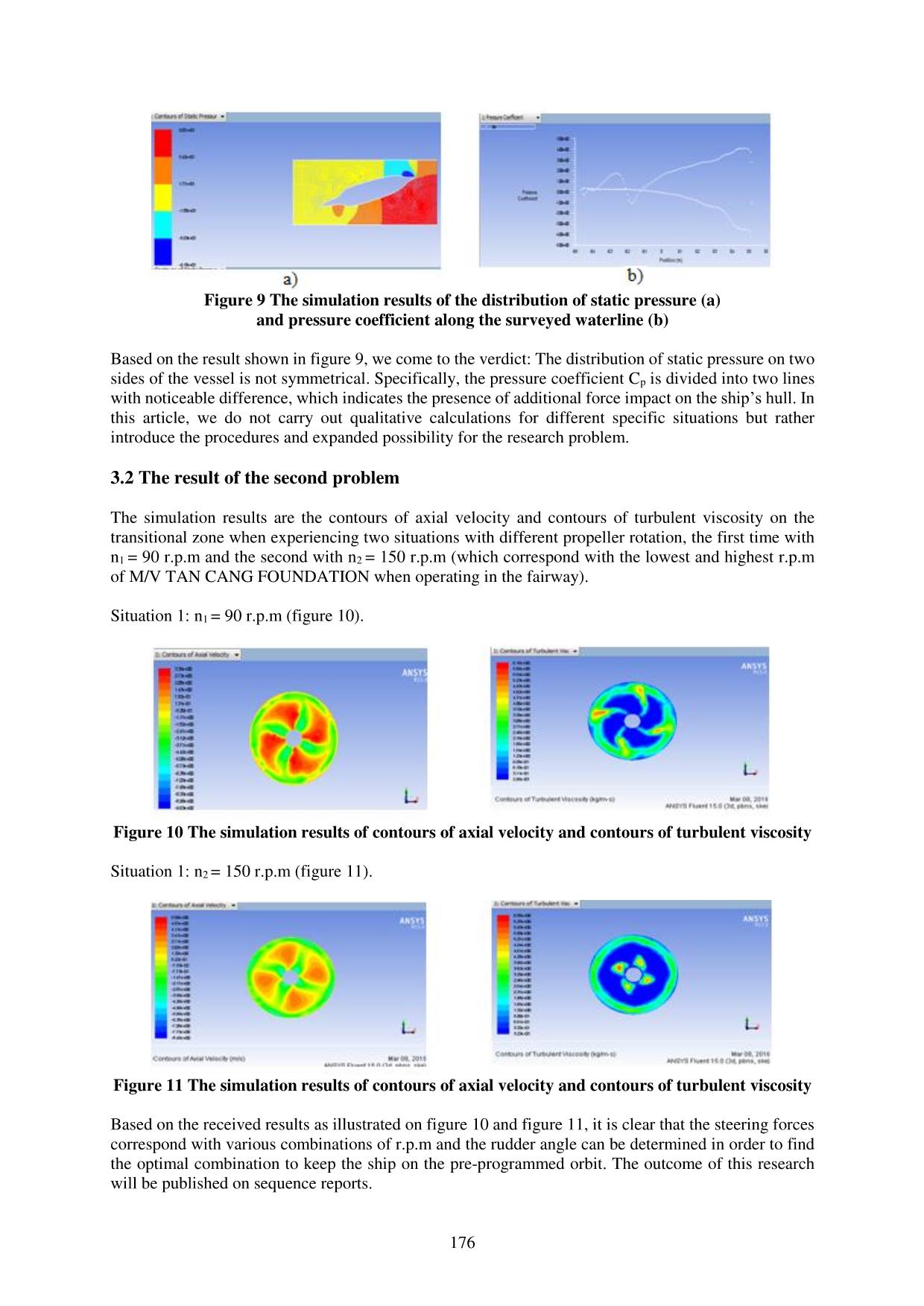
Trang 7

Trang 8
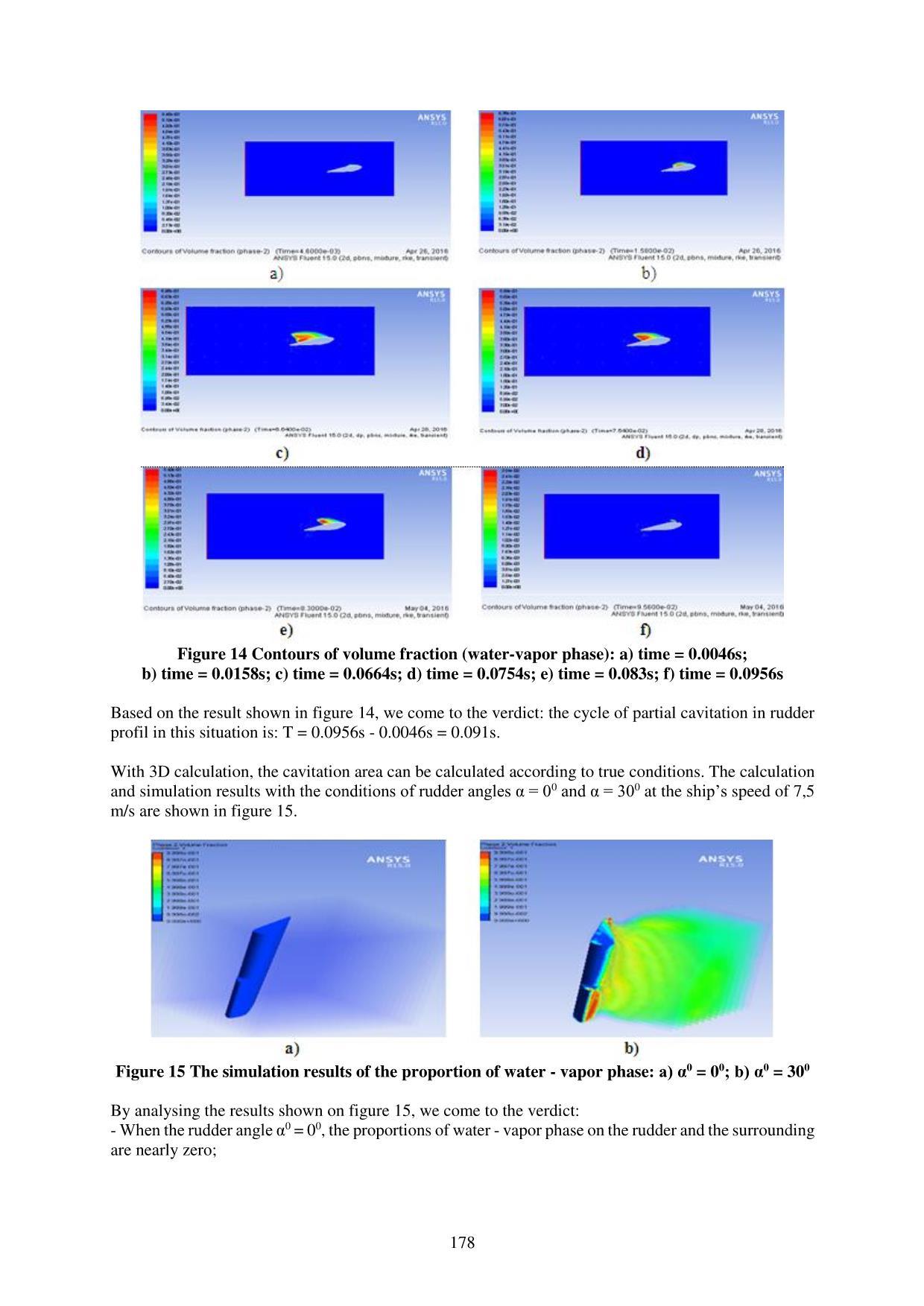
Trang 9
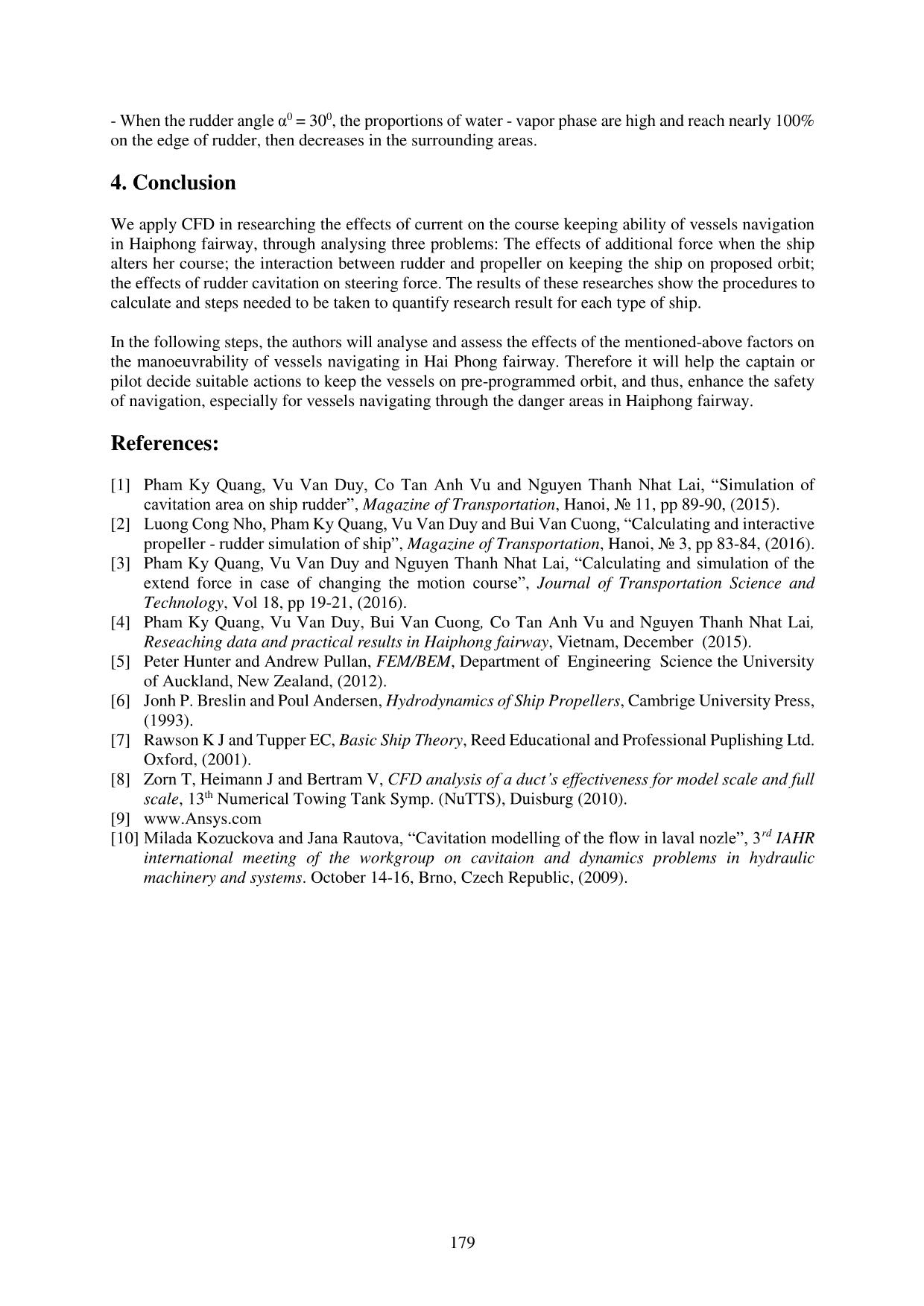
Trang 10
Tóm tắt nội dung tài liệu: Calculation and simulation of the current effects on maritime safety in Haiphong fairway, Vietnam
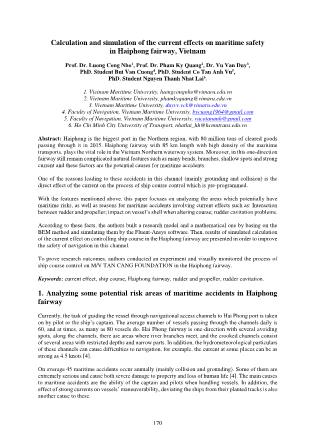
170 Calculation and simulation of the current effects on maritime safety in Haiphong fairway, Vietnam Prof. Dr. Luong Cong Nho1, Prof. Dr. Pham Ky Quang2, Dr. Vu Van Duy3, PhD. Student Bui Van Cuong4, PhD. Student Co Tan Anh Vu5, PhD. Student Nguyen Thanh Nhat Lai6. 1. Vietnam Maritime University, luongcongnho@vimaru.edu.vn 2. Vietnam Maritime University, phamkyquang@vimaru.edu.vn 3. Vietnam Maritime University, duyvv.vck@vimaru.edu.vn 4. Faculty of Navigation, Vietnam Maritime University, bvcuong1964@gmail.com 5. Faculty of Navigation, Vietnam Maritime University, vucotananh@gmail.com 6. Ho Chi Minh City University of Transport, nhatlai_hh@hcmutrans.edu.vn Abstract: Haiphong is the biggest port in the Northern region, with 80 million tons of cleared goods passing through it in 2015. Haiphong fairway with 85 km length with high density of the maritime transports, plays the vital role in the Vietnam Northern waterway system. Moreover, in this one-direction fairway still remain complicated natural features such as many bends, branches, shallow spots and strong current and these factors are the potential causes for maritime accidents. One of the reasons leading to these accidents in this channel (mainly grounding and collision) is the direct effect of the current on the process of ship course control which is pre-programmed. With the features mentioned above, this paper focuses on analyzing the areas which potentially have maritime risks, as well as reasons for maritime accidents involving current effects such as: Interaction between rudder and propeller; impact on vessel’s shell when altering course; rudder cavitation problems. According to these facts, the authors built a research model and a mathematical one by basing on the BEM method and simulating them by the Fluent-Ansys software. Then, results of simulated calculation of the current effect on controlling ship course in the Haiphong fairway are presented in order to improve the safety of navigation in this channel. To prove research outcomes, authors conducted an experiment and visually monitored the process of ship course control on M/V TAN CANG FOUNDATION in the Haiphong fairway. Keywords: current effect, ship course, Haiphong fairway, rudder and propeller, rudder cavitation. 1. Analyzing some potential risk areas of maritime accidents in Haiphong fairway Currently, the task of guiding the vessel through navigational access channels to Hai Phong port is taken on by pilot or the ship’s captain. The average number of vessels passing through the channels daily is 60, and at times, as many as 80 vessels do. Hai Phong fairway is one-direction with several avoiding spots, along the channels, there are areas where river branches meet, and the crooked channels consist of several areas with restricted depths and narrow parts. In addition, the hydrometeorological particulars of these channels can cause difficulties to navigation, for example, the current at some places can be as strong as 4.5 knots [4]. On average 45 maritime accidents occur annually (mainly collision and grounding). Some of them are extremely serious and cause both severe damage to property and loss of human life [4]. The main causes to maritime accidents are the ability of the captain and pilots when handling vessels. In addition, the effect of strong currents on vessels’ maneuverability, deviating the ships from their planted tracks is also another cause to these. 171 Maritime accidents occur mainly in four areas (which are numbered by order of their locations, starting from Hai Phong main port to the buoy № 0, as shown in figure 1), as following [4]: Area I: The confluence of the Cam and Ruot Lon rivers. This is a very narrow area, with floodplains near the mouth of Ruot Lon river on one side and the main berths of Hai Phong port on the other. The channel depth is low and the current is strong in this area, especially at high water. Furthermore, small vessels and watercrafts usually cross between the Cam river and the Ruot Lon river and this can easily create the risk of collision with vessels moored to berth or being aground at Ruot Lon river bank. Area II: The confluence of the Cam and the Bach Dang rivers. There are many floodplains near the mouth of Bach Dang river. The traffic density in the area is extremely high, and the Rules of the Road are not very well observed. With the tide, the current always tends to the direction of motion of the ship to the shore of Thuy Nguyen district. Therefore, there are very high risks of collision and running aground in this area. Figure 1 Four potential risk areas of maritime accidents in Haiphong fairway a) Area I; b) Area II; c) Area III; d) Area IV Area III: The junction of the Cam river, Nam Trieu, Cai Trap and Ha Nam channels. There are many shallow areas at the water near Dinh Vu peninsula and the mouth of the Bach Dang river. The traffic density is high and the nature of traffic is complicated in this area, especially between buoys № 30 and № 32. In addition, this area is known to be with strong and unstable currents, along with several anchorage areas and ferry terminals. Area IV: The junction of Ha Nam, Cai Trap channels and the inland waterway leading to Quang Ninh provice. Many inland ships, barges and water crafts cross the channel to enter Cai Trap channel, 172 especially around buoys № 19, № 21 and № 23. Furthermore, the area where larger vessels enter Lach Huyen chanel is accompanied by extremely strong and unstable current. The large number of both seagoing and inland waterway vessels passing through Cai Trap and Ha Nam channels makes the risk of maritime accidents in this area more serious. Summary: In order to assist the captain and pilot in deciding the optimal routes to guide their ships through the above - mentioned areas, which will enhance the safety of navigation in the area, the authors have carried out the calculation and simulation of the current effects on the course keeping ability of vessels navigating in the fairways of Hai Phong port by calculating three problems, namely: Impact on vessel’s shell when altering course; Interaction between rudder and propeller; Rudder cavitation problems, based on the results of field surveys, by analysizing values and evaluation practice received, with the experimental data are performed on the M/V TAN CANG FOUNDATION operating on the navigational access channels to Hai Phong Port. 2. Research models and mathematical principles 2.1 The model ship for research Our research object is the effects of current on the course keeping ability of vessels navigation in Haiphong fairway. In order to facilitate the field surveys and collect experimental data for calculation and simulation, the authors used a congruent model of M/V TAN CANG FOUDATION (figure 2) (this is a container ship with the capacity of 420 TEU operating in the route between Hai Phong port and Sai Gon port) [1, 2, 4, 7]. Figure 2 The model congruent of M/V TANCANG FOUNDATION The first problem: When the ship alters her course, the current impact on vessel’s shell will make additional forces (not considering the effects of the wind). To determine the additional force as well as to analyse its effects on the ship’s maneuverability, we gave a research model according to figure 3 [3]. Figure 3 The research model with conditions as described in the situation of the first problem Air outlet Air inlet Water-liquid outlet Water-liquid inletFree surface 173 The second problem: The interaction between rudder and propeller with different combinations of propeller rotation and rudder angle, as illustrated in figure 4 is researched and the result of which is analysed to find the optimal combination to keep the vessel on the pre-programmed orbit [2, 5, 6]. Figure 4 The research model for solving the second problem The third problem: Calculating and stimulating the effects of cavitation rudder (figure 5) can help determine the steering forces of ship during this period. The results will be used to assess the effects of cavitation rudder on course keeping abilities of vessels navigating in Haiphong fairway. Figure 5 The research model for solving the third problem 2.2 Mathematical principles We apply CFD in researching the effects of current on course keeping abilities of vessels navigating in the area. For three proposed problems, the VOF (volume of fluid) model, mixture for cavitation problem and others models, such as [1, 2, 3, 9]: k-, k-,... are used. - The method of VOF for solving differential equations with various phases, by adding the value of volume fraction, if αk is the volume fraction of the number k phase, then: 1 1 n k k (1) If k is the density of the number k phase, the density of the mixture will be: 1 n k k k (2) Propeller R u dd er Rudder Input Propeller Output Tr an sit io n al zo n e 174 Then, we solve major differential equations to determine specific values: 1 1 k n k k k pk kp kk v s m m t (3) The value of volume fraction is determined by time step: 1 1 1 1 1 1 k n n n n n n n nk k k k k k kf pk kp f k U s m m V t (4) In the equation: n - the previous time step; (n+1) - the current time step; αkf - the representative value of volume fraction of the number k phase; V - the volume of the calculating element; Uf - the volume of water flowing through the surface according to linear methods; kpm - the mass transferred from phase number p to phase number k; sαk = 0. The velocity distribution and energy can be determined by momentum equation and energy equation: tv v v p v v g F t (5) eff hE v E p k T st (6) T - temperature; E - energy and the value of E can be determined according to (7): 1 1 / n n k k k k k k k E E (7) The standard equation describes the flow and turbulence effect in the mixture model. The vapor transport equation determines the vapor mass fraction fvap by the following equation. . . . .j vapvap vap vap e c j j j ff f u R R t x x x (8) In which: Re, Rc dependent on the values of static pressure p and saturation vapor pressure pvap: If p < pvap: 2 1 3 vapch e e l vap vap l p pvR C f (9) If p > pvap: 2 3 vapch c c l l vap l p pvR C f (10) In which: vch - characteristic velocity (m/s); Ce, Cc - empirically constants (Ce = 0.02; Cc = 0.01) [8,10]. 3. Analysing results 3.1 The result of the first problem Due to the limitation of the article, we calculate two situations with input parameters as following: - Situation 1: The ship’s true course is 0000, the speed Vs is 5 m/s, wind speed Vw is 0 m/s. - Situation 2: The ship’s true course is 0150, the speed Vs is 5 m/s, wind speed Vw is 0. 175 Figure 6 The simulation results of the distribution of static pressure on both sides of the vessel (the submerged area only) (a) and contour of volume fraction (air) (b) In situation 1, the distribution of static pressure on both sides of the ship is nearly symmetrical. In order to have a more detailed look, we can analyse one waterline as following: Figure 7 The simulation results of the distribution of static pressure (a) and pressure coefficient along the surveyed waterline (b) Based on the result shown in figure 7, we come to the verdict: The distribution of static pressure on both side of the waterline is symmetrical and the pressure distributing coefficient along the waterline on both side of the vessels are near equal. There is no additional force impact on the ship’s hull in this situation. When the ship alters her course to 0150 (situation 2), this situation can be considered as if the current flew around the ship’s hull with an angle of 150 to the ship’s center line. The simulation result is measured on the same waterline as in situation 1. Figure 8 The simulation results of the distribution of static pressure on both sides of the vessel (submerged area only) a) b) 176 Figure 9 The simulation results of the distribution of static pressure (a) and pressure coefficient along the surveyed waterline (b) Based on the result shown in figure 9, we come to the verdict: The distribution of static pressure on two sides of the vessel is not symmetrical. Specifically, the pressure coefficient Cp is divided into two lines with noticeable difference, which indicates the presence of additional force impact on the ship’s hull. In this article, we do not carry out qualitative calculations for different specific situations but rather introduce the procedures and expanded possibility for the research problem. 3.2 The result of the second problem The simulation results are the contours of axial velocity and contours of turbulent viscosity on the transitional zone when experiencing two situations with different propeller rotation, the first time with n1 = 90 r.p.m and the second with n2 = 150 r.p.m (which correspond with the lowest and highest r.p.m of M/V TAN CANG FOUNDATION when operating in the fairway). Situation 1: n1 = 90 r.p.m (figure 10). Figure 10 The simulation results of contours of axial velocity and contours of turbulent viscosity Situation 1: n2 = 150 r.p.m (figure 11). Figure 11 The simulation results of contours of axial velocity and contours of turbulent viscosity Based on the received results as illustrated on figure 10 and figure 11, it is clear that the steering forces correspond with various combinations of r.p.m and the rudder angle can be determined in order to find the optimal combination to keep the ship on the pre-programmed orbit. The outcome of this research will be published on sequence reports. 177 3.3 The result of the third problem In case of the rudder angle of α = 350 (the maximum permitted rudder angle) and the input parameter of speed is 7,5 m/s (the highest permitted speed for vessels navigating in the fairway), with profil in the midship position of the rudder, the calculated results with specific values are displayed on the coloured column on the left of each figure, specifically: The distribution of water-vapor phase, pressures coefficient and pressure distribution on figure 12. Figure 12 The simulation results of water - vapor phase (a), pressures coefficient (b), pressure distribution (c) This is the situation where the cavitation can be seen most clearly, because, as the input parameters of current speed and rudder angle are of the highest values. On figure 12a, it is clear that the size of the cavitation area reaches 100% in water-vapor phase, starting from the edge to profil and enclosed on profil with the length of the cavitation area on profil is 0.175 m. According to the classification of cavitation, this is partial cavitation. In addition, there is also a cavitation area on the edge of profil, which is shown on figure 13. Figure 13 The simulation result of cavitation area on the edge of profil The pressure coefficients and the pressure distribution on the profil are shown in figure 12b and figure 12c. The cavitation area will have the value of static pressure equal to the saturation vapour pressure of water, which is 3540 N/m2. This explains why the pressure coefficient in this area is of horizontal type (it is called the cavitation length l). With different input parameters of speed, the values of l will vary and the cavitation area on the edge of profil will change accordingly. Moreover, the type of cavitation in this area is partial cavitation, which is a type of unstable cavitation that forms, grows, and disappears in certain cycles. This makes the value of steering force to fluctuate while maintaining speed and steering angle and causes difficulties to maneuvering of ship. The calculated results of partial cavitation area in one cycle are shown below: 178 Figure 14 Contours of volume fraction (water-vapor phase): a) time = 0.0046s; b) time = 0.0158s; c) time = 0.0664s; d) time = 0.0754s; e) time = 0.083s; f) time = 0.0956s Based on the result shown in figure 14, we come to the verdict: the cycle of partial cavitation in rudder profil in this situation is: T = 0.0956s - 0.0046s = 0.091s. With 3D calculation, the cavitation area can be calculated according to true conditions. The calculation and simulation results with the conditions of rudder angles α = 00 and α = 300 at the ship’s speed of 7,5 m/s are shown in figure 15. Figure 15 The simulation results of the proportion of water - vapor phase: a) α0 = 00; b) α0 = 300 By analysing the results shown on figure 15, we come to the verdict: - When the rudder angle α0 = 00, the proportions of water - vapor phase on the rudder and the surrounding are nearly zero; 179 - When the rudder angle α0 = 300, the proportions of water - vapor phase are high and reach nearly 100% on the edge of rudder, then decreases in the surrounding areas. 4. Conclusion We apply CFD in researching the effects of current on the course keeping ability of vessels navigation in Haiphong fairway, through analysing three problems: The effects of additional force when the ship alters her course; the interaction between rudder and propeller on keeping the ship on proposed orbit; the effects of rudder cavitation on steering force. The results of these researches show the procedures to calculate and steps needed to be taken to quantify research result for each type of ship. In the following steps, the authors will analyse and assess the effects of the mentioned-above factors on the manoeuvrability of vessels navigating in Hai Phong fairway. Therefore it will help the captain or pilot decide suitable actions to keep the vessels on pre-programmed orbit, and thus, enhance the safety of navigation, especially for vessels navigating through the danger areas in Haiphong fairway. References: [1] Pham Ky Quang, Vu Van Duy, Co Tan Anh Vu and Nguyen Thanh Nhat Lai, “Simulation of cavitation area on ship rudder”, Magazine of Transportation, Hanoi, № 11, pp 89-90, (2015). [2] Luong Cong Nho, Pham Ky Quang, Vu Van Duy and Bui Van Cuong, “Calculating and interactive propeller - rudder simulation of ship”, Magazine of Transportation, Hanoi, № 3, pp 83-84, (2016). [3] Pham Ky Quang, Vu Van Duy and Nguyen Thanh Nhat Lai, “Calculating and simulation of the extend force in case of changing the motion course”, Journal of Transportation Science and Technology, Vol 18, pp 19-21, (2016). [4] Pham Ky Quang, Vu Van Duy, Bui Van Cuong, Co Tan Anh Vu and Nguyen Thanh Nhat Lai, Reseaching data and practical results in Haiphong fairway, Vietnam, December (2015). [5] Peter Hunter and Andrew Pullan, FEM/BEM, Department of Engineering Science the University of Auckland, New Zealand, (2012). [6] Jonh P. Breslin and Poul Andersen, Hydrodynamics of Ship Propellers, Cambrige University Press, (1993). [7] Rawson K J and Tupper EC, Basic Ship Theory, Reed Educational and Professional Puplishing Ltd. Oxford, (2001). [8] Zorn T, Heimann J and Bertram V, CFD analysis of a duct’s effectiveness for model scale and full scale, 13th Numerical Towing Tank Symp. (NuTTS), Duisburg (2010). [9] www.Ansys.com [10] Milada Kozuckova and Jana Rautova, “Cavitation modelling of the flow in laval nozle”, 3rd IAHR international meeting of the workgroup on cavitaion and dynamics problems in hydraulic machinery and systems. October 14-16, Brno, Czech Republic, (2009).
File đính kèm:
 calculation_and_simulation_of_the_current_effects_on_maritim.pdf
calculation_and_simulation_of_the_current_effects_on_maritim.pdf

